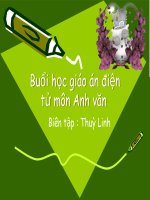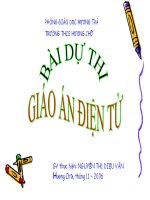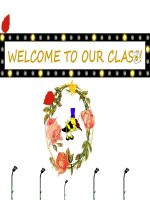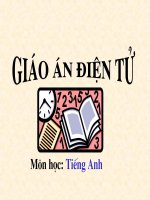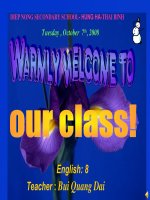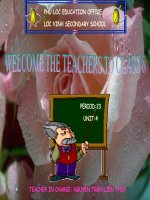Unit 4 Our costum and traditions
Bạn đang xem bản rút gọn của tài liệu. Xem và tải ngay bản đầy đủ của tài liệu tại đây (229.93 KB, 25 trang )
<span class='text_page_counter'>(1)</span>Date of preparing: 04.11.2015 Date of teaching: 05.11.2015. UNIT 4: OUR CUSTOMS AND TRADITIONS Period: 26 Lesson 1: Getting started. I. Aims: 1. Skills: - Listening skills: Listen and read the conversation between teacher, Mi, Mai and Nick. - Writing skills: Write true or false for the sentences and the answers. - Language practice: + Vocabulary: the lexical items related to the topic "Our customs and traditions" + Grammar: Review - Individual skills, pairwork skills. 2. Knowledge: By the end of the lesson sts will be able to: have the opportunity to explore the table manners in the UK and compare them with those in Viet Nam. 3. Attitude: Educate ss to learn hard and to have knowledge about People of Viet Nam. II. Resources: notebooks, extra board. III. Procedures: - Class orgnization - The new lesson: Getting started. ACTIVITIES CONTENTS ACTIVITY 1 WARM UP * Purpose: This activity focus sts develop on their knowledge of the (3 minutes) table manners. - Instruction: Discuss and free talk about the customs and traditions in Viet Nam. - Task: Form of learning: work in pairs. Introduction Review the previous unit before Ss open their books by asking them to take part in a small game. Ss work in two big groups A and B. A student from group A calls out the name of an ethnic group in Viet Nam, then points at one student from group b. This student has to call out the name of another ethnic group. The game stops when a group cannot give out the name of any ethnic group or when time is up. The group with more ethnic groups wins. Write this sentences on the board and ask Ss to complete it. -Yes, and they have their own ways of life, and…..and…… Tell Ss that this sentence is taken from the conversation in the Getting started of Unit 3. When Ss can give you the two words ‘custom’ and ‘traditions’. If within two minutes Ss cannot complete the sentence, ask them to quickly look at the conversation on page 26 and find the sentence..
<span class='text_page_counter'>(2)</span> Write the unit title on the board ‘ Our customs and traditions’. Ask Ss to call out some customs and traditions they know. Now start the lesson. 1* Purpose: This activity focus sts develop on their knowledge of the table manners. - Instruction: Discuss and free talk about the customs and traditions in Viet Nam. - Task: Form of learning: work in pairs. Ask Ss to open their books and look at the picture and the phrase under Getting started. Ask them some questions: Who can you see in the picture? What do you think the people in the picture are talking about? Ss answer the questions as a class. Play the recording and have Ss follow along. After that, Ss can compare their answers with the information in the dialogue and add some more details to their answers. a Ss work independently to find the words with the given meanings in the dialogue. Allow them to share answers before discussing as a class. Remember to ask Ss to read out the lines in the dialogue that contain the words. Quickly write the correct answers on the board.. Key: 1.accepted 3.spot on 5.social. 2.generations 4.sharp 6.table manners. Have Ss look at the Watch out! Box and quickly read the information. Ask if they know any expressions with the same meaning as ‘You’re kidding’. Some other expressions are: You must be kidding!/ You’re joking!/You must be joking! b Ss read the conversation again to do this exercise. Ask for Ss’ answers as well as the explaination for their choices. Write the correct answers on the board..
<span class='text_page_counter'>(3)</span> Key: 1.T 2.F( There are also social ones.) 3.T 4.F( There are a lot of customs for table manners in the UK) c Have Ss read the questions to make sure they understand them. Ask them firstly to answer the questions without reading the dialogue. Ss exchange their answers with a classmate. Now ask them to check their answers by reading the dialogue again. Call some Ss to write their answers on the board. Confirm the correct answers. Key: 1.It’s eating dinner at 7 p.m. sharp. 2.He’s surprised. 3.They both refer to doing something that develops over time. 4.A custom is something accepted. A tradition is something special and is passed down through the generations. 5.They should find information about a custom or tradition. d Ss do this in pairs. Ask for Ss’ answers and their explanations. Summarise the answers. Key: 1.have to: It’s an obiligation – you have no choice 2.should: It’s a suggestion or advice – it would be best to follow it. 2* Purpose: This activity focus sts develop on their knowledge of the table manners. - Instruction: Discuss and free talk about the customs and traditions in Viet Nam. - Task: Form of learning: work in pairs. a Have Ss look at the pictures. Ask them what they see in each of them. Now tell Ss that in the box are some customs and traditions of VietNamese people. Ss read these and identify any new words they do not know. Explain the new words so that Ss understand the customs and traditions. Ss do this activity in pairs. Call some Ss to give their answers and write them on the board. Confirm the correct answers.. Key:. 1.g 4.h. 2.c 5.e. 3.f 6.a.
<span class='text_page_counter'>(4)</span> 7.b. 8.d. b Individually Ss decide if the pictures show customs or traditions and compare their answers in pairs. Their answers may differ. Have some Ss give the answers to the class and explain their choice. Suggested answers: 1.C 2. C or T 3. C 4.T 5.C 6.C 7. T 8. C or T. 3 Game: * Purpose: This activity focus sts develop on their knowledge of the table manners. - Instruction: Discuss and free talk about the customs and traditions in Viet Nam. - Task: Form of learning: work in pairs. Organise a competition for this activity. Ss work in groups of five or six. Set a time limit of five minutes. Ss write down as many local customs and traditions as possible. The group with the most customs and traditions is the winner. The winning group presents their customs and traditions. Other groups add more if they can. ACTIVITY 8 Sts Repeat the content of the lesson. T: Remarks the students’ study (2 minutes) - Learn by heart vocabulary and complete the exercises into notebook. - Prepare: A closer look 1 Teacher’s reflection. …………………………………………………………………… ……………………………………………………………………… ……………………………………………………………………… ……………………………………………………………………… ……………………………………………………………………… ………………………………. Date of preparing: 04.11.2015 Date of teaching: 05.11.2015. UNIT 4: OUR CUSTOMS AND TRADITIONS Period: 27 Lesson 2: A closer look 1.
<span class='text_page_counter'>(5)</span> I. Aims: 1. Skills: - Writing skills: Write the sentences with should or shouldn’t and form of have to. - Speaking skills: Work in pairs, discuss and give the advice for partner. - Listening skills: Listen and write true or false for the sentences in 2. - Language practice: + Vocabulary: the lexical items related to the topic "Our customs and traditions" + Grammar: Review - Individual skills, pairwork skills. 2. Knowledge: By the end of the lesson sts will be able to: have the opportunity to explore the table manners in the UK and compare them with those in Viet Nam. 3. Attitude: Educate ss to learn hard and to have knowledge about People of Viet Nam. II. Resources: notebooks, extra board. III. Procedures: - Class orgnization - The new lesson: Communication ACTIVITIES CONTENTS ACTIVITY 1 WARM UP * Purpose: This activity focus sts develop on their knowledge of the (3 minutes) table manners. - Instruction: Discuss and free talk about the customs and traditions in Viet Nam. - Task: Form of learning: work in pairs. Introduction Ask Ss to call out some customs and traditions they remember from thr previous lesson. Tell them that in this lesson they are going to learn some expressions with the words custom and ‘tradition’. These will help them vary their language when talking about customs and traditions. Vocabulary * Purpose: This activity focus sts develop on their knowledge of the table manners. - Instruction: Discuss and free talk about the customs and traditions in Viet Nam. - Task: Form of learning: work in pairs. Draw Ss’ attention to the Watch out! Box. Explain to them the words ‘custom’ and tradition’ can be countable or uncountable. Remember to come back to this point after finishing exercise 1. 1 Have Ss look at the table in the book. Make sure that they understand what to do. Ss complete the exercise individually and then compare their anwers with a.
<span class='text_page_counter'>(6)</span> partner. Call some Ss to give the answers. Write them on the board. Confirm the correct answers.. Key:. 1.e 4.g. 2.d 5.b. 3.a 6.c. 7.f. Now have Ss read the sentences again to see if the word ‘custom’ or ‘tradition’ in each sentence is countable (C) or uncountable (U). Ask for Ss’ answers.. Key:. 1.C 4.C. 2. C 5.U. 3.U 6.C. 7. C. 2* Purpose: This activity focus sts develop on their knowledge of the table manners. - Instruction: Discuss and free talk about the customs and traditions in Viet Nam. - Task: Form of learning: work in pairs. Have Ss read the sentences in 1 again and complete the expressions. Then Ss compare their answers with a partner. Call one or two Ss to write the complete expressions on the board.. Key: 1.custom 3.according 5.with. 2.tradition 4.tradition 6.of. 7.doing. 3* Purpose: This activity focus sts develop on their knowledge of the table manners. - Instruction: Discuss and free talk about the customs and traditions in Viet Nam. - Task: Form of learning: work in pairs. Ask Ss to work in groups to do this activity. T may prepare some pieces of big-size paper for the groups to write their answers on. When they finish, Ss stick their paper on the board. Ss read and comment on each other’ sentences. 4* Purpose: This activity focus sts develop on their knowledge of the table manners. - Instruction: Discuss and free talk about the customs and traditions in Viet Nam. - Task: Form of learning: work in pairs. Ss individually complete the sentences with their own ideas, then share their sentences with a partner. Ask for Ss’ answers and write them on the board..
<span class='text_page_counter'>(7)</span> Don’t say if they are right or wrong. Then play the recording for them to check the answer and repeat the words. Play the recording as many times as necessary.. Key: 1.strictly 2.strangers,spread 3.streets 4.filmstrip 5.offspring. ACTIVITY 8 Sts Repeat the content of the lesson. T: Remarks the students’ study (2 minutes) - Learn by heart vocabulary and complete the exercises into notebook. - Prepare: A closer look 2 Teacher’s reflection. …………………………………………………………………… ……………………………………………………………………… ……………………………………………………………………… ……………………………………………………………………… ……………………………………………………………………… ………………………………. Date of preparing: 04.11.2015 Date of teaching: 05.11.2015. UNIT 4: OUR CUSTOMS AND TRADITIONS Period: 28 Lesson 3: A closer look 2. I. Aims: 1. Skills: - Writing skills: Write the sentences with should or shouldn’t and form of have to. - Speaking skills: Work in pairs, discuss and give the advice for partner. - Listening skills: Listen and write true or false for the sentences in 2. - Language practice: + Vocabulary: the lexical items related to the topic "Our customs and traditions" + Grammar: Review - Individual skills, pairwork skills. 2. Knowledge: By the end of the lesson sts will be able to: have the opportunity to explore the table manners in the UK and compare them with those in Viet Nam. 3. Attitude: Educate ss to learn hard and to have knowledge about People of Viet Nam. II. Resources: notebooks, extra board. III. Procedures: - Class orgnization - The new lesson: A closer look 2.
<span class='text_page_counter'>(8)</span> ACTIVITIES CONTENTS ACTIVITY 1 WARM UP * Purpose: This activity focus sts develop on their knowledge of the (3 minutes) table manners. - Instruction: Discuss and free talk about the customs and traditions in Viet Nam. - Task: Form of learning: work in pairs. Grammar Should and shouldn’t to express advice: review Give a situation: Your brother is going out with a friend. The weather forecast says it’s a hot sunny day. Give him some advice. Encourage Ss to express their advice freely. If Ss mention should/shouldn’t, tell them that in this lesson they are going to review should/shouldn’t to express advice about customs and traditions. If Ss do not mention should/shouldn’t, remind them of the modal verb. 1 * Purpose: This activity focus sts develop on their knowledge of the table manners. - Instruction: Discuss and free talk about the customs and traditions in Viet Nam. - Task: Form of learning: work in pairs. Ask Ss to look at the pictures and quickly describe what they see. Have them complete the sentences and then compare the answers with a friend. Elicit Ss’s answers. Confirm the correct ones.. Key: 1.should 3.should. 2.shouldn’t 4.shouldn’t. 5.should. 2* Purpose: This activity focus sts develop on their knowledge of the table manners. - Instruction: Discuss and free talk about the customs and traditions in Viet Nam. - Task: Form of learning: work in pairs. Have Ss read the situations in A to make sure they understand them. Ss do this activity in pairs. Ask for Ss’s answers. For a more able class, have Ss give some other advice for the situations. Ss may write their advice on a big piece and show it to the class.. Key:. 1.b 3.e. 2.c 4.d. 5.a.
<span class='text_page_counter'>(9)</span> Have Ss to express obligation or necessarity Tell Ss that sometimes when they go to a place, it is obligatory that they follow its customs and traditions. Have Ss read the information about have to. T may want to add that must is also used to express obligation. One of the differences between have to and must is that must shows internal obligation, i.e., you make a decision about what you must do. Give one example: We must clean the house before Tet because we think it will bring luck. Then have Ss read the Remember! box. Answers any questions from Ss. If time allows, ask Ss to give examples with the grammar points discussed. 3* Purpose: This activity focus sts develop on their knowledge of the table manners. - Instruction: Discuss and free talk about the customs and traditions in Viet Nam. - Task: Form of learning: work in pairs. Ss do this exercise individually, and then compare their answers with a classmate. Check Ss’s answers and confirm the correct ones. Key: 1.have to 2.have to 3.has to 4.had to, don’t have to 5.does…have to 6.didn’t have to 4* Purpose: This activity focus sts develop on their knowledge of the table manners. - Instruction: Discuss and free talk about the customs and traditions in Viet Nam. - Task: Form of learning: work in pairs. Ss do this exercise individually and give T their answers. Key: 1.B 2.A 3.A 4.B 5* Purpose: This activity focus sts develop on their knowledge of the table manners. - Instruction: Discuss and free talk about the customs and traditions in Viet Nam. - Task: Form of learning: work in pairs. Have Ss quickly read the e-mail. Ss do this exercise individually.
<span class='text_page_counter'>(10)</span> and then compare the answers with a classmate. Ask one or two Ss to write their answers on the board. Have them explain their answers as well. Key: 1. Shouldn’t give-> should give (reason: There are lots of confusing customs and traditions in Japan, so Eri thinks she should give Mi advance) 2. Has to->have to (reason: the pronoun ‘you’ goes with ‘have to’) 3. Shouldn’t wear->should wear (reason: Eri says that Mi should take off her shoes when going inside, which means she should wear slippers) 4. Didn’t have to-> don’t have to (reason: this sentence is in the present time) 5. Have use-> have to use(reason: ‘have to’ is the correct form) 6. Should worry->shouldn’t worry(reason:Eri says she’ll be there to help Mi, so Mi shouldn’t worry) 6* Purpose: This activity focus sts develop on their knowledge of the table manners. - Instruction: Discuss and free talk about the customs and traditions in Viet Nam. - Task: Form of learning: work in pairs. Ss work in pairs to do this task. Ask some pairs to write their advice and obligations on the board. Other Ss give comments and vote for the best advice and obligations. Then they can add some more. This is an open activity so encourage Ss to express their ideas as long as the advice and obligations are appropriate. If time does not allow, T may call a good student to give an example. Then Ss may do this as homework. However, remember to check their answers in the next lesson. ACTIVITY 8 Sts Repeat the content of the lesson. T: Remarks the students’ study (2 minutes) - Learn by heart vocabulary and complete the exercises into notebook. - Prepare: Communication.
<span class='text_page_counter'>(11)</span> Teacher’s reflection. …………………………………………………………………… ……………………………………………………………………… ……………………………………………………………………… ……………………………………………………………………… ……………………………………………………………………… ………………………………. Date of preparing: 04.11.2015 Date of teaching: 05.11.2015. UNIT 4: OUR CUSTOMS AND TRADITIONS Period: 29 Lesson 4: Communication. I. Aims: 1. Skills: - Writing skills: Write T or F for the sentences. - Speaking skills: Work in pairs, discuss and say the different of two pictures and say about these table manner. - Listening skills: Listen and write true or false for the sentences in 2. - Language practice: + Vocabulary: the lexical items related to the topic "Our customs and traditions" + Grammar: Review - Individual skills, pairwork skills. 2. Knowledge: By the end of the lesson sts will be able to: have the opportunity to explore the table manners in the UK and compare them with those in Viet Nam. 3. Attitude: Educate ss to learn hard and to have knowledge about People of Viet Nam. II. Resources: notebooks, extra board. III. Procedures: - Class orgnization - The new lesson: Communication ACTIVITIES CONTENTS ACTIVITY 1 WARM UP * Purpose: This activity focus sts develop on their knowledge of the (3 minutes) table manners..
<span class='text_page_counter'>(12)</span> - Instruction: Discuss and free talk about the table manners in Viet Nam. - Task: Form of learning: work in pairs. Tell Ss that in this lesson they will have the opportunity to explore the table manners in the UK and compare them with those in Viet Nam. ACTIVITY 2 * EXTRA VOCABULARY * Purpose: This activity focus sts develop on their vocabulary. (5 minutes) - Instruction: Introduce vocabulary - Task: Form of learning: work individual Go through the Extra vocabulary with Ss. If Ss do not know any word in the box, quickly teach it. T can teach the words ‘prong’, ‘cutlery’, ‘tray’ and ‘mat’ by using the pictures provided in 1. To teach the word ‘palm’, point to the T’s palm. To teach the word ‘host/hostess’, T can give an explanation. When you invite some guests to your hourse, your mother is the hostess and your father is the host.. - prong [prɔη] (n): răng, ngạnh, chĩa, cái chĩa (để đảo rơm) - cutlery /’kʌtləri/ (n): dao kéo, bộ đồ dùng ăn - tray [trei] (n): cái khay, cái mâm chiếu, thảm chùi chân - mat /mæt/ (n): cây cọ, cây họ cau dừa - palm /pɑ:m/(n): Ong chủ nhà>< bà chủ nhà - host /houst/: (n) hostess /'houstis/ ACTIVITY 3 1. Look at the pictures below. In pairs, discuss the differences (10 minutes) between them. * Purpose: This activity focus sts develop on their speaking skills. - Instruction: Look at the picture, in pairs and discuss the differences between them. - Task: Form of learning: work in pairs In pairs Ss look at the pictures and discuss the differences between them. Encourage them to use the extra vocabulary. Some suggested differences are: * Suggested answer: - In the first picture, people are sitting on the mat to have the meal. In the second picture, they are sitting around the dinning table. - In the first picture, people are using rice bowls and chopsticks. In the second picture, they are using cutlery. - In the first picture, people don’t have drink. In the second picture, people drink champane. ACTIVITY 4 2. Read the following sentences about table manners in Britain. Work in pairs. Write T (true) or F (false). (5 minutes) * Purpose: This activity focus sts develop on their writing skills. - Instruction: Read the following sentences about table manners in.
<span class='text_page_counter'>(13)</span> Britain. Work in pairs. Write T (true) or F (false). - Task: Form of learning: work in pairs Ss work in pairs to decide if the statements are true or false. Have some Ss write their answers on the board. Do not confirm the correct answers now. ACTIVITY 5 3. Now listen to Nick giving a presentation on table manners in (10 minutes) Britain and check your answers. * Purpose: This activity focus sts develop on their listening skills. - Instruction: Listen to Nick giving a presentation on table manners in Britain and check your answers. - Task: Form of learning: work individually Play the recording for Ss to check their answers. Ss listen to the recording twice. If there are any incorrect answers, have Ss explain why the sentences are false. * Suggested answer: 1. F (You hold the folk in the left hand and the knife in the right) 2. T 3. F (There is also a spoon and a fork for dessert.) 4. T 5. F ( You should never use your own cutlery to take more food from the serving dish spoon) 6. F ( You should break off the bread with your hands ) 7. F ( Guests have to wait until the host or hostess starts eating.) 8. T ACTIVITY 6 4. Work in pairs. Discuss if you follow these table manners in your family. Are there other table manners in Britain and check (5 minutes) your answers. * Purpose: This activity focus sts develop on their speaking skills. - Instruction: Work in pairs. Discuss if you follow these table manners in your family. Are there other table manners in Britain and check your answers. - Task: Form of learning: work in pairs The aims of this activity is to provide Ss with some Vietnamese table manners. Ss may know them all but may lack the language to talk about them. This activity also help Ss brainstorm more ideas for the next activity. In pairs Ss discuss if they know the same table manners in their family. They may add some more. Remember to set a time limit for this activity. Some Ss present their ideas. T may quickly write some of the Ss’ extra table manners on the board. ACTIVITY 7 5. There is a Bristish exchange student in your class. You invite.
<span class='text_page_counter'>(14)</span> her to dinner at your home. Play the following roles. * Purpose: This activity focus sts develop on their speaking skills. - Instruction: There is a Bristish exchange student in your class. You invite her to dinner at your home. Play the following roles. - Task: Form of learning: work in pairs Ss work in pairs and role-play. They continue the conversation in the book or make up their own. After some time, call some pairs to act out the conversation in front of the class. Other Ss give comments. Give praise and feedback on Ss’ conversations. ACTIVITY 8 Sts Repeat the content of the lesson. T: Remarks the students’ study (2 minutes) - Learn by heart vocabulary and complete the exercises into notebook. - Prepare: Skills 1 (5 minutes). Teacher’s reflection. …………………………………………………………………… ……………………………………………………………………… ……………………………………………………………………… ……………………………………………………………………… ……………………………………………………………………… ………………………………. Date of preparing: 04.11.2015 Date of teaching: 06.11.2015. UNIT 4: OUR CUSTOMS AND TRADITIONS Period: 30 Lesson 5: Skills 1. I. Aims: 1. Skills: - Reading skills: Read and answer the question. - Speaking skills: Work in pairs, discuss the questions then interview. - Language practice: + Vocabulary: the lexical items related to the topic "Our customs and traditions" + Grammar: Review - Individual skills, pairwork skills..
<span class='text_page_counter'>(15)</span> 2. Knowledge: By the end of the lesson sts will be able to: Read for specific information about family customs and traditions and ask about and describe different customs and traditions. 3. Attitude: Educate ss to learn hard and to have knowledge about People of Viet Nam. II. Resources: notebooks, extra board. III. Procedures: - Class orgnization - The new lesson: Skills 1 ACTIVITIES CONTENTS ACTIVITY 1 WARM UP * Purpose: This activity focus sts develop on their knowledge of the (3 minutes) table manners. - Instruction: Discuss and free talk about the table manners in Viet Nam. - Task: Form of learning: work in pairs. ACTIVITY 2 READING 1. Look at the pictures and answer the questions. (5 minutes) * Purpose: This activity focus sts develop on their describing about the pictures. - Instruction: Look at the pictures and answer the questions. - Task: Form of learning: work in pairs. Have Ss look at the pictures and anwer the questions in pairs. Elicit answers from Ss. * Suggested answers: Picture 1: A family is celebrating a birthday. Picture 2: People are making Chung cake. Picture 3: A family is at an amusement park. ACTIVITY 3 2. Read Mi’s presentation on customs and traditions. Is she (10 minutes) writing about her family or her society? * Purpose: This activity focus sts develop on their reading skills. - Instruction: Read Mi’s presentation on customs and traditions then answer the question. - Task: Form of learning: work in pairs. Ask Ss to read the passage quickly and tell if Mi is writing about her family or her society. Elicit the answers from Ss. ? Is she writing about her family or her society? * Suggested answers: - She’s writing about her family * Vocabulary:. - generation (n): /,dʤenə'reiʃn/ - anniversary (n): /,æni’və:səri/. sự sinh ra, sự phát sinh ra, thế hệ ngày kỷ niệm; lễ kỷ niệm.
<span class='text_page_counter'>(16)</span> - lasagne (n): [lə’zænjə] - grilled chicken (n): /grild/ - sense of belonging - course (n):. món bột với cà chua và nước xốt và phó mát hấp chung gà nướng cảm giác thân thuộc món ăn. ACTIVITY 4 3. Now decide in which paragraph each detail below is mentioned. Write A, B, or C in the blank. (5 minutes) * Purpose: This activity focus sts develop on their reading skills. - Instruction: Read Mi’s presentation on customs and traditions again then write A, B, or C in the blank. - Task: Form of learning: work in pairs. It is the first time this type of reading exercise has appeared in the textbook, so T should instruct Ss on the way to do it: - Read the statements and underline the key words, e.g. in statement 1, the key words are ‘name’ and ‘Italian dish’ - Begin with statement 1; read through the passage quickly and locate the key words. - Stop to read the part that includes the key words more carefully to make sure the information matches. T: may model with the first statement. Ss work individually then compare their answers with a classmate before giving the answers to T. * Suggested answers: 1.C 2. A 3. C 4. B 5. A 6. B * Vocabulary: tồn tại, sống - existed /ig'zist/ (V): bề dài, chiều dài, độ dài - long (a) -> length (n): /leɳθ/ ACTIVITY 5 4. Read the text again and answer the questions. * Purpose: This activity focus sts develop on their reading skills. (5 minutes) - Instruction: Read the text again and answer the questions. - Task: Form of learning: work in pairs. Ss read the passage again to answers. Ss compare the questions. Ss can underline parts of the text that help them with the answers. Ss compare their answers before giving the answers to T. Ask them to give evidence when giving the answers. * Suggested answers: 1. They are: having lunch together on the second day of Tet, spending Sunday together, and celebrating her grandparents’ wedding anniversary on the first Sunday of October. 2. They usually go to the cinema or go for a picnic together. 3. They don’t remember. 4. They made five-coloured sticky reice served with grilled chicken..
<span class='text_page_counter'>(17)</span> 5. They live family customs and traditions because they provide a sense of belonging. ACTIVITY 6 SPEAKING 5. Work in pairs and discuss the questions. (5 minutes) * Purpose: This activity focus sts develop on their speaking skills. - Instruction: Work in pairs and discuss the questions. - Task: Form of learning: work in pairs. In pairs, Ss take turns to ask each other the three questions about their own family customs and traditions. T can move about the class, facilitating where necessary and assessing how Ss are doing. * Suggested answers: ACTIVITY 7 6. Interview another pair to get their answers to the questions in (10 minutes) 5. note down their answers in the table below. Then present what you have found out to the class. * Purpose: This activity focus sts develop on their speaking skills. - Instruction: Interview another pair to get their answers to the questions in 5. note down their answers in the table below. Then present what you have found out to the class. - Task: Form of learning: work in pairs. Now two pairs of Ss join together. One pair interviews the other. One S interviews and the other notes down the answers in the table. Then, the second pair interviews the first pair. Ss spend a few minutes preparing the findings to the whole class. If there is not much time, T may just have Ss complete activity 5. Ss interview each other in pairs and report the findings to the whole class. ACTIVITY 8 Sts Repeat the content of the lesson. T: Remarks the students’ study (2 minutes) - Learn by heart vocabulary and complete the exercises into notebook. - Prepare: Skills 2 Teacher’s reflection. …………………………………………………………………… ……………………………………………………………………… ……………………………………………………………………… ……………………………………………………………………… ……………………………………………………………………… ………………………………. Date of preparing: 06.11.2015 Date of teaching: 11.11.2015. UNIT 4: OUR CUSTOMS AND TRADITIONS Period: 31 Lesson 6: Skills 2.
<span class='text_page_counter'>(18)</span> I. Aims: 1. Skills: - Listening skills: Listen and write the words you hear, then tick true or false. - Writing skills: Read then write about traditional Japanese dance. - Language practice: + Vocabulary: the lexical items related to the topic "Our customs and traditions" + Grammar: Review - Individual skills, pairwork skills. 2. Knowledge: By the end of the lesson sts will be able to: Listen to get specific information about a traditional dance of an ethnic and write a description of a traditional Japanese dance 3. Attitude: Educate ss to learn hard and to have knowledge about People of Viet Nam. II. Resources: notebooks, extra board. III. Procedures: - Class orgnization - The new lesson: Skills 2 ACTIVITIES CONTENTS ACTIVITY 1 WARM UP 1. Look at the picture. What tradition do you think this is? (3 minutes) Share your ideas with a partner. * Purpose: This activity focus sts develop on their knowledge of the Thai dance. - Instruction: Look at the picture and share your ideas with a partner about the traditional dance in Viet Nam. - Task: Form of learning: work in pairs. Ss look at the picture and share what they know about this tradition with a partner. Elicit Ss’ answers and have them share as much information as possible. Write the name of the traditional dance on the board: The xoe dance. ACTIVITY 2 LISTENING 2. Listen to Mai’s presentation and complete the table with no (10 minutes) more than three words from the recording. * Purpose: This activity focus sts develop on their listening skills. - Instruction: Listen to Mai’s presentation and complete the table with no more than three words from the recording. - Task: Form of learning: work individually. Tell Ss that they are going to listen to Mai’s presentation on the xoe dance and complete the table. Play the recording once. Ask for Ss’ answers and write them on the board. If all the answers are correct, move to the next activity. If Ss are not sure about their answers, play the recording again for Ss to check. Make changes to the answers on.
<span class='text_page_counter'>(19)</span> the board but do not confirm the correct ansers now. * Suggested answers: 1. happy and wealthy 5. social 2. private gatherings 6. fire 3. 30 7. the music 4. the circle dance 8. culture and lifestyle * Vocabulary:. - express (v): /iks'pres/ - perform (v): /pə'fɔ:m/ - wealthy (a): /'welθi/ - unity (n): /'ju:niti/. biểu lộ, bày tỏ. làm (công việc...); thực hiện (lời hứa...) giàu, giàu có tính thuần nhất, tính duy nhất, đoàn kết phản chiếu, phản ánh, dội lại. - reflect (v): /ri'flekt/ riêng, tư, cá nhân - private (a): /private/ ACTIVITY 3 3. Listen again and tick true or false. * Purpose: This activity focus sts develop on their listening skills. (5 minutes) - Instruction: Listen to Mai’s presentation again and tick true (T) or false (F). - Task: Form of learning: work individually. Without listening to the recording again, Ss decide if the sentences are true of false. If they meet any difficulty doing this, play the recording again. Have Ss compare the answers for both 2 and 3. * Suggested answers: 1. T 2. F 3. F 4. T 5. T If there is not much time, Ss can skip activity 3. * Vocabulary: (thuộc) linh hồn, tôn giáo - spiritual /'spiritjuəl/ - conical hat /'kɔnikəl/ nón khăn quàng cổ, khăn choàng cổ - scarve (n) /skɑ:f/ ACTIVITY 4 WRITING 4. Work in pairs. Read about a traditional Japanese dance. (5 minutes) Make complete sentences using the information given. * Purpose: This activity focus sts develop on their writing skills. - Instruction: Work in pairs. Read about a traditional Japanese dance. Make complete sentences using the information given. - Task: Form of learning: work in pairs. - In this writing part, Ss are asked to write a description of a traditional Japenese dance, the Obon dance. - Ss work in pairs and make sentences using the given information. This activity can provide scaffolding for the next activity. If time allows, Ss are encouraged to write down the full sentences; otherwise, they make full sentences orally. T should move around to.
<span class='text_page_counter'>(20)</span> give comments as there may not be enough time for checking with the whole class. - With classes they need more support, T may ask Ss to do activity 4 more carefully. Ask some Ss to write the sentences on the board and check them with the whole class. Then have Ss write the description at home and bring it back in the next lesson. * Vocabulary:. - honouring /'ɔnə/ - yagura - high wooden stage - clockwise (adv): ['klɔkwaiz] - counter-clockwise (adv). danh dự, danh giá, thanh danh. Sân khấu bằng gỗ cao Theo chiều kim đồng hồ ngược chiều kim đồng hồ. /'kauntə'klɔkwaiz/ nhóm lại, họp lại; ghép lạ - reunite (v)[,ri:ju:'nait] Lễ hội, lời nhận xét dí dỏm - Obon (n): ACTIVITY 5 5. Imagine that you are joining a writing contest about customs and traditions and have chosen to write about the Obon dance. (10 minutes) Now write a descrition of this dance. Begin with the following sentence. * Purpose: This activity focus sts develop on their writing skills. - Instruction: Imagine that you are joining a writing contest about customs and traditions and have chosen to write about the Obon dance. Now write a descrition of this dance. Begin with the following sentence. - Task: Form of learning: work in pairs. Ss write their descriprion individually based on the sentences they have made, beginning with the given sentence. Ss may also write this in groups on big pieces of paper. ACTIVITY 6 6. When you have finished, swap your work with a partner. Did they add anything different? Can you spot any mistakes in their (10 minutes) work? Share your ideas. * Purpose: This activity focus sts develop on their writing skills. - Instruction: When you have finished, swap your work with a partner. Work in pairs. - Task: Form of learning: work in pairs. Ss or groups exchange their descriptions to spot any mistakes. Share them with the whole class. T may collect some Ss’ work to mark at home or ask them to review the descriptions as homework. In this case, remember to ask for Ss’ revised work in the next lesson. Note that the audio script provides a good model of a written description of a dance. This structure can be used to describe the Obon dance..
<span class='text_page_counter'>(21)</span> Did they add anything different? Can you spot any mistakes in their work? ACTIVITY 8 Sts Repeat the content of the lesson. T: Remarks the students’ study (2 minutes) - Learn by heart vocabulary and complete the exercises into notebook. - Prepare: Looking back + Project Teacher’s reflection. …………………………………………………………………… ……………………………………………………………………… ……………………………………………………………………… ………………………………………………………………………. Date of preparing: 06.11.2015 Date of teaching: 11.11.2015. UNIT 4: OUR CUSTOMS AND TRADITIONS Period: 32 Lesson 7: Looking back. I. Aims: 1. Skills: - Writing skills: Write the correct words into the gaps. Write about network and correct form of “should”. - Speaking skills: Say about these activities of festival in the world. - Language practice: + Vocabulary: the lexical items related to the topic "Our customs and traditions" + Grammar: Review - Individual skills, pairwork skills. 2. Knowledge: By the end of the lesson sts will be able to: Listen to get specific information about a traditional dance of an ethnic and write a description of a traditional Japanese dance 3. Attitude: Educate ss to learn hard and to have knowledge about People of Viet Nam. II. Resources: notebooks, extra board. III. Procedures: - Class orgnization - The new lesson: Looking back ACTIVITIES CONTENTS ACTIVITY 1 WARM UP 1. Complete the folowing wordwebs with the customs and (5 minutes) traditions you know or have learnt. * Purpose: This activity focus sts develop on their knowledge of the customs and traditions. - Instruction: Complete the folowing wordwebs with the customs.
<span class='text_page_counter'>(22)</span> ACTIVITY 2 (5 minutes). ACTIVITY 3 (10 minutes). ACTIVITY 4 (5 minutes). and traditions you know or have learnt. - Task: Form of learning: work in pairs. Set a time limit for this activity. Within three or five minutes, Ss write down as many family and social customs and traditions in the wordwebs as possible. Draw four wordwebs on the board and have two Ss write their answers on the board. T and other Ss comment on the answers. This is an open activity, so accept all the answers provided that they are right. - Family customs and traditions: don’t sweep the floor on the first day of Tet, don’t chew and talk at the same time, have meals together,…. - Social customs and traditions: respect old people, bring things from adults with both hands, bring gift whne you visit someone’s house VOCABULARY 2. Complete the sentences with the words from the box. * Purpose: This activity focus sts develop on their vocabulary of the customs and traditions. - Instruction: Complete the sentences with the words from the box. - Task: Form of learning: work in pairs. Ss do this activity individually then compare their answers with a partner. Ask some Ss to write their sentences on the board. T and other Ss give comments. * Suggested answers: 1. respect 2. workshipping 3. wrap 4. host 5. cutlery 6. generations 3. Write sentences with the following expressions. * Purpose: This activity focus sts develop on their knowledge of the customs and traditions. - Instruction: Write sentences with the following expressions. - Task: Form of learning: work in pairs. Ss do this activity individually, then compare their sentences with a partner. Ask some Ss to write their sentences on the board. T and other Ss give comments. GRAMMAR 4. Complete the senteces, using ‘should or shouldn’t’ and a verb from the box. * Purpose: This activity focus sts develop on their knowledge of the customs and traditions. - Instruction: Complete the senteces, using ‘should or shouldn’t’ and a verb from the box. - Task: Form of learning: work in pairs..
<span class='text_page_counter'>(23)</span> ACTIVITY 5 (10 minutes). ACTIVITY 6 (5 minutes). ACTIVITY 7 (3 minutes). Ss do this exercise individually and then share the answers with a classmate. Check their answers. * Suggested answers: 1. shouldn’t wait 2. shouldn’t use 3. shouldn’t break 4. should follo 5. shouldn’t touch 5. Underline one mistake in each of the following sentences. Correct it. * Purpose: This activity focus sts develop on their using vocabulary skills. - Instruction: Underline one mistake in each of the following sentences. Correct it. - Task: Form of learning: work in pairs. Ss underline one mistake in each sentence and correct it. They are also encouraged to explain their correction. Elicit the answers from Ss. * Suggested answers: 1. has to->have to 2. should->shouldn’t 3. have to has->have to have 4. should to-.should 5. have avoid->have to avoid COMMINICATION 6. Game: What should I do? In small groups, take turn to choose one of these scenarios for each other. Once everyone has had a turn at answering, vote for the person who gave the best advice. * Purpose: This activity focus sts develop on their using vocabulary skills. - Instruction: Underline one mistake in each of the following sentences. Correct it. - Task: Form of learning: work in pairs. Ss work in groups to play the game. One student is the group secretary. Group members take turns to choose one of the scenario for each other. The secretary writes down the advice each member gives. Finally, the group votes for the person giving the best advice. Or: Ss work in groups, discuss and write down the advice for all the scenarios on a big piece of paper. When time is up, they present the results to the class. Afterwards, the class votes for the best advice. Finished! Ask Ss to complete the self-assessment. Identify any difficulties and weak areas and provide further practice. Project Customs and traditions: How they have changed.
<span class='text_page_counter'>(24)</span> Tell Ss that customs and traditions may change over time. Ask SS if they know any custom or tradition that has changed. Elicit Ss’s answers. Some customs and traditions that may have changed are those celebrating weddings and the Tet holiday, throwing housewarming parties… Ss work in groups to do the project following the instructions in the book. Answer Ss’s questions if there are any. Remember to have Ss present their findings in the next lesson and vote for the best. ACTIVITY 8 Sts Repeat the content of the lesson. T: Remarks the students’ study (2 minutes) - Learn by heart vocabulary and complete the exercises into notebook. - Prepare: Unit 5: Getting started Teacher’s reflection. …………………………………………………………………… ……………………………………………………………………… ……………………………………………………………………… ………………………………………………………………………. Date of preparing: 07.11.2015 Date of teaching: 12.11.2015. Period: 33 Correcting the test. I. Objectives: 1. KiÕn thøc: - Nhằm đánh giá mức độ làm bài của học sinh. - Giúp học sinh nhận ra và sửa chữa những lỗi sai thờng mắc phải để lần sau không lặp lại những lỗi sai đó nữa. - Tìm ra những học sinh yếu về các kỹ năng nào để từ đó giáo viên có biện pháp giúp đỡ thích hợp. - Gióp häc sinh häc tËp nh÷ng c¸ch tr×nh bµy bµi kiÓm tra s¹ch sÏ, khoa häc cña b¹n. 2. KÜ n¨ng: Rèn cho HS kĩ năng làm các dạng bài tập..
<span class='text_page_counter'>(25)</span> 3. Thái độ: Chỳ ý và tiếp thu cỏc ý kiến nhận xột bài của GV. II. Procedures: 1. Warmer - Greeting. - Checking attendance. - Asking for the teaching date. 2. New lesson - Give the commom comment about sts’ test. - Give the test for sts. S: Look at the test and share and swap with friends. T: Point out their mistakes for sts which many sts have. + Writing skill is limited. + Listening skill is bad. + Reading skill need to improve. + Grammar mistakes: + Spelling: ThiÕu dÊu c©u, ®Çu c©u kh«ng viÕt hoa, kho¶ng c¸ch gi÷a c¸c tõ trong c©u qu¸ liÒn nhau,... T: Ask sts to correct the exercises in the test. T: Ask sts to go to the board and do exercises again. S: Do exercises T: Have sts check and correct exercises S: Check and correct T: Correct and explain S: Listen and write III. Homework: - Prepare the next lesson..
<span class='text_page_counter'>(26)</span>
